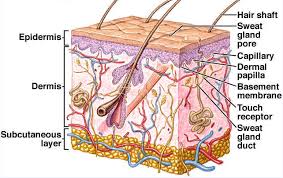
Integumentry system of vertebrates
Vertebrate Integumentary Systems
Keratin, an insoluble protein in the outer layer of the vertebrate skin, helps prevent water loss and dehydration and has contributed to the successful adaptation to life on land. Keratin is also the major protein found in nails, hooves, horns, hair, and wool. Feathers, scales, claws and beaks of birds and reptiles are also composed of keratin.
Human Integumentary System
The human integumentary system is made up of the skin, hair, nails, and glands, and serves many protective functions. It prevents excessive water loss, keeps out microorganisms that could cause illness, and protects underlying tissue from mechanical damage. Pigments
called melanin to absorb and reflect the sun’s harmful ultraviolet radiation. The skin also helps regulate body temperature. If heat builds up, sweat glands produce more sweat, which evaporates and cools the skin. In addition, when the body overheats, blood vessels expand and bring more blood to the skin surface, allowing body heat to be lost. If the body is too cold, on the other hand, blood vessels in the skin contract, putting less blood at the body surface and conserving heat. In addition, the skin serves as a minor excretory organ, since sweat removes small amounts of nitrogenous wastes produced by the body, and functions as a sense organ since it contains millions of nerve endings that detect touch, heat, cold, pain, and pressure. Finally, the skin produces vitamin D in the presence of sunlight and renews and repairs damage to itself.


